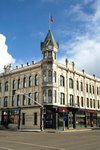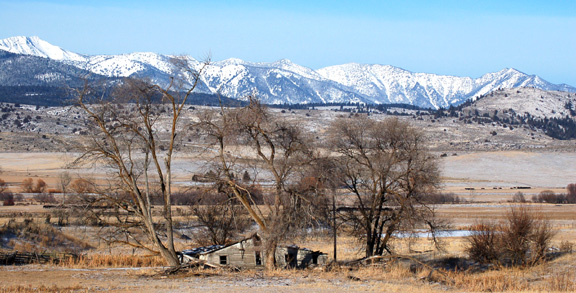New Police Building?
Speed Trap on 17th Street
Charley Reese: Cut Israel Loose
Former Governor Kitzhaber On Medical Care

All This Public Space Isn't Enough For the Public Employees Serving the 10,000 Or So People In Baker City?
Our population had remained fairly constant over the years, but our tax burden and the needs of City bureaucracies grow.

Buy a new police building for over $700,000 or perhaps $1 million with interest?
I am told the building above has been on the market for some time. Two years? Councilor Calder says “the current price we are looking at is more than double the assessed value . . . and $200,000 more than what the assessor says the real market value of that building is. That is a real concern. We have to live within the budget of the citizens of Baker City. . . . . the building across the street that’s the same size sold for. . . less than $200,000. This is Baker City and we have to look at the real numbers.”
And What About A Democratic Public Process?
There were lots of interesting articles in the papers tonight that relate to the purchase of a new police department building. Brian Addison had an interesting and valuable editorial in The Record Courier about the 4th Amendment that deserves further comment, but he also had an editorial that was at odds with the facts. Brian's claims run counter to an earlier article by Jayson Jacoby in the Herald, and my own statements, that dealt with the finality of the purchase of the police building and the not so public process that surrounded it. Given the seeming vagueness of the comments and final motion at the February 26th Council meeting, I can understand the differing interpretations that have been offered concerning Council autorization of the purchase, but the lack of a public process is clearly evident in the public record.
In tonight’s March 6th edition of The Record Courier, Brian ran a headline that said “City Council Has Not Passed Final Authorization for New Police Building.” The Herald ran an article on the front page, by Jayson Jaycoby, on February 27th with the headline: “City to buy building.” My understanding of the basis for Jayson’s comments is that all that remained was for the Council to approve a resolution that would amend the budget so as to allow the purchase to proceed. After asking around and viewing the tape, that was my understanding too. Back in 2006, I asked the Council to provide video tapes of Council meetings to the Baker County Public Library so that those who don’t get cable or are unable/unwilling to attend the meeting would be able to view the proceedings. After a reminder that they had not provided the library a tape for eight months, the City Manager started providing them again beginning with the February 26th meeting. The tape provides a second, separate, objective record of what occurs at the meetings. I must admit, after reviewing the tape, that the transcript leaves the question open to interpretation, but there should be little doubt about whether the Council authorized a purchase of the building on Auburn Street.
Early in the February 26th discussion, Sam Bass said that the Council would “still have to approve the price. We are only giving him permission to go forward with the purchase—what he brings us back—price—we have to approve that price.” To me, that sounds like approval to purchase the building with the price to be approved by the Council.
Later, Brocato says “There is a time essence issue here. . . . . council is then not deciding to buy the building or not, but Council is looking at the budget resolution to pay for it. And that would be the next step that Councilor Bass is referring to.” OK, looks like Brocato thinks he has the authority to buy the building with only the final price to be approved by the Council.
The final resolution, offered by Councilor Schumacher, was “Well, I make a motion that we proceed with negotiating an earnest money agreement [I.e., a legally binding offer to purchase the building] to come back for Council approval whenever you [Brocato] come back with it.” It would appear that authorization was given to purchase the building with the only remaining issue needing approval being the price. So you look at the record in the library and then tell me what happened—perhaps we will need fired ex-City Attorney David Fine to unravel this one.
Technically, I think that Brian Addison’s statement about “Final Authorization” could be seen as correct, if you only consider that Council has to approve the price, but the authorization to purchase the building has been approved, and as long as the Council approves the price, which they seem more than willing to do, the police have a new building. If they don’t approve the first price Brocato brings back, he could always go back for a second or third, etc. (It will be interesting to see how this develops.)
But then Brian says in the editorial that “Those citizens currently crying foul and claiming that not enough public process has been allowed during the city’s consideration of purchasing a new building for the police station, should realize that they are involved in a very public process they are claiming doesn’t exist.” Say what?
Councilor Schumacher made similar statements at the February 26th meeting:
“You cannot grab the people and make them come and learn. They are going to react after we make a decision and say ‘Why didn’t you consult with me when they had the opportunity to be at this meeting’—they could have been at other meetings, and you have voted me in as your representative, until you vote me out, to make those decisions for you. . . . . This is always the way it comes out. . . you make a decision and then there is a reaction as a result of a decision you made, and why didn’t you consult me?”
Mr. Schumacher, are you referring to the meetings where the purchase was considered in executive sessions that excluded the public and was added to the agenda at the last minute? Does someone have to come down to the intimidating council chamber and stand before you for their views to be considered? Do you dismiss opinions submitted in writing via snail-mail or e-mail?
As Jayson Jaycoby relayed to the public in an editorial on March 4th (Why not wait 2 weeks?):
“What bothers us is that the City Council voted to buy the building at 1768 Auburn Ave. just 2 months after councilors first discussed the possible purchase.
Neither that discussion, nor a second one that took place during the Council's Feb. 12 meeting, was listed on the meeting agenda, so residents who are interested in the topic had no way to know councilors would be talking about it.
In fact, most of the Dec. 12 discussion, and the whole of the Feb. 12 discussion, took place during an executive session, from which the public is excluded as allowed under Oregon's public meetings law.
Then, during the public portion of the Council's Feb. 26 meeting, city officials laid out their case for buying the Auburn Avenue building.
Until then, the city had said so little, publicly, about its proposal that residents could hardly have formed well-considered opinions about the city's plan to buy the building.
And unfortunately, they never had the chance to do so.
Less than half an hour after city officials finished their presentation on Feb. 26, the Council voted 3-2 to authorize City Manager Steve Brocato to negotiate a deal with the building's owners.”
Jayson’s statements are accurate, as an examination of the publicly available agendas and minutes will substantiate. Further, I have been unable to find any mention of the need for the purchase in Chief Lohner’s columns appearing in The Record Courier from early December to present. The first substantive article about the purchase didn't appear until the Herald featured it on February 22nd, 4 days before the Council meeting where Brocato was told to bring back an earnest money agreement. Do we deserve the steam roll/ “dog & pony show” treatment?
One question those opposed to the “below the radar” approach for buying a new police building have raised, concerns information sharing about our city’s needs and priorities (Calder’s & Duman’s statements, Vickie Valenzuela’s letters, etc). Why haven't the Council and City Manager communicated their plans, and the need for them, to the public far in advance of a meeting where they authorize a purchase? One concern of mine, in addition to finding money for water and sewer infrastructure, is the condition of our city’s roads after the snowy winter of 2007-2008. Tonight, Jayson Jaycoby had a very informative article about how our roads have deteriorated in the last two decades, even prior to the effects caused by our severe winter. You have no doubt noticed, especially if you travel down Grove, Resort, 15th, or any number of other streets. Fixing those roads won’t be cheap. The article points out that if we fix those streets on a twenty four year cycle, it will cost about a million dollars a year, and that we are spending less than half that. We aren’t keeping up with the maintenance and increased taxes are being considered. We still haven't resolved the expensive issue of providing adequate facilities for Baker City's school children--can't the police department building wait? Do we need to spend three quarters of a million to a million dollars, going into a recession, on a new police building when many pressing and basic needs are currently unmet?
As I, and others, have implied in statements on this subject, a new police building might be nice, but we can all think of things we’d be better off for having. The question we all face is can we afford them right now in the face of other pressing needs, and are we willing to pay a premium for things we would like, but don’t absolutely need to have? Can we give our citizens time to offer creative alternative solutions or are we subject to the dictates of a few self-interested parties working behind a veil of secrecy?
And as citizen Vickie Valenzuela has said, “Baker City is not a private business, it is a government business—the difference is public dollars.” And I would add, the difference is that this is not a corporation, it is supposed to be a responsive democracy that allows for and truly considers all of the public’s input.
-----
Speed Trap on 17th Street
Back on November 19, 2007, I sent the following message to Chief Lohner about seeming inconsistencies in the way speed is handled in different parts of the city, as well as some concerns about a stoplight and stop signs at uncontrolled intersections. Specifically:
"Hello Chief Lohner,
Saw your column in the Record Courier so sending these concerns along.
Myself and others have noticed that the traffic light at 10th and
Campbell seems to change without regard to existing traffic. It seems
to have a very short time period set for allowing Campbell vehicles to
cross 10th, and will turn red even when there are no vehicles in sight
on 10th Street. This, of course, wastes the time, brakes and gasoline
of the vehicles seemingly stopped for no reason on Campbell. Campbell
is a pretty busy route for traffic to and from the west side of town
and the recycle center so this situation affects a lot of people.
Would it be possible to get this light to remain green for vehicles on
Campbell when there is no approaching traffic on 10th Street (and
vice-versa)?
Additionally, the posted speed limit on Elm Street (Old Hwy. 30) from
the south end of town has a 35 MPH speed limit even though it is in a
fairly crowded residential area. 17th Street north of Campbell has a
25 MPH speed limit even though it passes through low density
residential and then industrial/vacant industrial areas. I have
noticed that many people exceed the speed limit on 17th, probably
because they see no safety related reason to go 25 MPH. Would you
consider advocating for a change in the speed limits for these two
streets? Seems like 35 would be better for 17th and 25 better for
Elm.
Lastly, a friend requested that I also ask you about the possibility
of controlling all the intersections in town with either stop or yield
signs. His observation was that too many people are going through
these intersections at a pretty decent clip without checking for cross
traffic.
Please consider these situations and let me know what the police
department thinks about them.
Thanks,"
Chief Lohner responded with:
"Mr. Christie,
Thank you for writing to me with your traffic safety concerns. I will be copying this response to our Department's traffic safety coordinator for follow up to include presenting the concerns to the Traffic Safety Committee.
With regard to the traffic light at 10th and Campbell and the speed limit on Elm Street (Old Hwy. 30), we'll have to leave those decisions up to ODOT, who has a representative on the Traffic Safety Committee. The City has little or no authority over those roadways, because 10th Street and Elm Street (Old Hwy. 30) are both State Highways. As for 17th Street, the City Council could make a recommendation to ODOT to change the speed, which would be at their discretion after an "engineering and traffic investigation indicates that the statutory speed for the highway is greater or less than is reasonable or safe under conditions the department finds to exist" (ORS 810.180).
As for your intersection question, I can tell you that we do have a unique community with so many uncontrolled intersections. However, even though we have considerably more uncontrolled intersections than controlled intersections in Baker City, we have far more traffic crashes at the controlled intersections than at the uncontrolled. Therefore, at this point and time I would have a hard time advocating for more intersection controls.
If the Traffic Safety Committee decides to recommend action on any of your concerns, I will let you know. Until then, if you have any further questions or concerns please let me know.
Chief Wyn Lohner"
A reasoned and polite reply. It turned out though that the officer who was going to transmit my concerns to the Traffic Safety Committee was on vacation at the time of the meeting, but I was told in February that he would see if he would transmit my concerns to the committee. OK.
Then in mid February, I was out early on a raptor count with a friend. We were traveling down 17th Street after turning right off of the new Settler's Loop Road. A woman in a Jeep Cherokee like vehicle had just passed the intersection, also traveling south at about 35 MPH. She was apparently oblivious of a police car parked facing north on the east side of the street just past Settler's Park. It was tucked away off the street in a large open area between the street and the warehouse-like building. Just after she passed, the police car turned on the flashing lights and flipped a u-turn, stopping her about two blocks south. As I had seen a police car there before, this incident gave weight to my belief that the Police Department was using the unusual situation as a speed trap. When I asked a friend who travels that section of road on a regular basis about that time of day (7:30-8:30 AM when people are going to work), he told me that the police use that location to catch unaware drivers on a fairly regular basis.

Speed Trap On 17th Street
Black line points to area where the police car is normally waiting.
I can see why they like that spot. Most people would assume that a safe speed limit would be 35 to 45 MPH due to the large industrial and unoccupied road frontage from around the Sheriff's office down to near Campbell. I'm guessing that is why many people travel around 35 MPH on that section. Plus, there are few signs to let them know about the low speed limit. If they miss the one in front of D&B up by Hughes Lane, they won't see another one going south until they hit a 20 MPH warning sign way down at the curve onto Auburn Avenue. Going north from Auburn, there is one sign at 'A' Street and another up at the Sheriff's office. That's it. If you come on to 17th from Settler's Loop, you won't find any sign to tell you what the speed limit is until you gat past Auburn. (Interestingly, Settler's Loop, which is completely vacant south of OTEC, has a new 25 MPH speed limit sign.
According to The Speed Trap Exchange, http://www.speedtrap.org/stetfite.htm
"The worst kind of speed trap is the one that is set up to deliberately entrap motorists and extort money for the benefit of police agencies or local governments. These speed traps employ absurdly low speed limits, intense enforcement, deliberately confusing signage (or no signage), and dishonest and or abusive local courts." 17th Street sure seems to fit.
All this said, I haven't seen police cars at that spot for the last week or so--ever since I mentioned it in an e-mail that was copied to Chief Lohner. But a word to the wise when traveling down 17th--exceeding the speed limit there, as unreasonable as that limit seems, could cost you some of your hard-earned money.
-----
Charley Reese: Cut Israel Loose
"Sometimes President Bush sounds like an idiot. The most recent example is his statement that he still believes the Palestinians and Israelis can reach a peace agreement before the end of his term.
This comes on the heels of an Israeli attack against Gaza that killed more than 100 people, most of them innocent civilians. It was a reprisal attack for a few rockets fired into Israel by some Hamas hotheads. In World War II, when the Germans killed civilians as a reprisal for an attack on their forces, it was called a war crime.
. . . . If the Palestinian rockets were slaughtering Israelis, no one could complain. Even an occupying power has a right to defend itself. But these rockets, unguided, more often than not land where people aren't. According to a recent story in the Los Angeles Times, only 13 Israelis have been killed by these rockets in the past seven years. Hamas says the rockets are in response to Israeli attacks; the Israelis say the reprisal raid is in response to the rocket attacks.
Such circular action-reactions remind one of the wisecrack that if the world practices the old Hebrew "eye for an eye and tooth for a tooth" philosophy, the world would soon be blind and toothless. Unless the Israelis are willing to do as the Romans did and exterminate every Palestinian man, woman and child, they can't kill their way to peace. And neither can the Palestinians. . . . .
The United States should stop the $3 billion annual gift to the Israelis and tell them that as of now, the U.S. will no longer protect them from United Nations sanctions or criticism with our veto. Israel is quick to say it is a sovereign and independent country; well, it's time the U.S. put that to the test."
Whole Article:
http://www.antiwar.com/reese/?articleid=12480
-----
Former Governor Kitzhaber On Medical Care
In this must-see video, ex-governor Kitzhaber explains why our medical care system doesn't work.
http://wcdb.us/unfinished-business-of-the-baby-boom-generation-460.html
Kitzhaber talking points on our broken US health care system:
http://wecandobetter.org/sites/archi.trunk/files/Talking%20Points.pdf












No comments:
Post a Comment